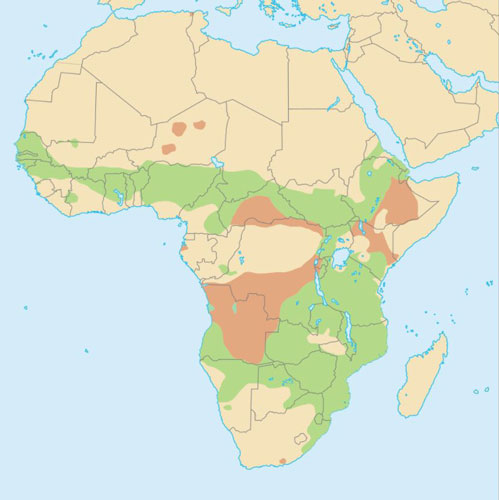 |
 |
Phacochoerus africanus
Facocero (Sp), Warzenschwein (G), Phacochère (F), Vlakvark (Af). Generic name is from the Greek phakos (wart) and khoiros (pig or hog). Africanus is for the Ethiopian Region, which includes sub-Saharan Africa.
DESCRIPTION Shoulder height 25-33 inches (64-84 cm). Weight 110-250 pounds (50-115 kg).
The warthog is an ugly pig with a huge head, a long body and well-developed tusks. The upper tusks form a semicircle outward, upward and inward. The lower tusks wear against the base of the upper tusks, honing sharp cutting edges. The skin is almost hairless except for a long, thin mane of coarse hairs on the neck and back. The natural skin color is gray, but may appear red or yellow because of the animal's habit of wallowing in mud. Males have prominent "warts"-which are skin growths with no bony support or obvious function-on the sides of the head and beneath the eyes. The tail is long and thin, hairless except for the terminal tuft, and is carried upright with the tufted tip hanging over when the warthog runs. Females are similar to males, but smaller, without prominent warts, and with smaller tusks.
BEHAVIOR Gregarious, living in bands of 4-6, though sometimes as many as 40, consisting of established groups of females and young, or temporary groups of young males. Adult males are usually solitary. Males join the females briefly during the mating season and engage other males in ritualized battles in which injuries are rare. Mating seasons are clearly defined and vary with the region. After 5-1/2 to 6 months gestation, 2-3 piglets are born (litter size ranges from 1-8). Warthogs are sexually mature at 18-20 months, and have lived as long as 18 years in captivity.
Normally diurnal unless heavily hunted. Active morning and afternoon, resting at midday and at night. Utilizes holes-either natural ones or aardvark holes-for refuge, sleeping, and to rear young. Usually enters a hole by backing in. Eats mainly grass, but also fruit, bark, bulbs, roots, small animals and carrion. Avoids cultivation, thus normally is not detrimental to agriculture. Likes water for drinking and bathing but can do without it if need be. Senses of smell and hearing are acute, eyesight is rather poor. Top running speed is 35 mpg (55 km/h). Normally inoffensive, but will defend itself bravely and can inflict severe wounds with the small, sharp lower tusks. The longer upper tusks are used in digging.
HABITAT Savanna and open forest.
DISTRIBUTION Widespread throughout Africa south of the Sahara, except in rain forests.
REMARKS Not a top game animal, but a welcome addition to the bag nonetheless. Usually plentiful enough and good to eat, with tusks that can be judged on the hoof. Warthogs make excellent leopard bait.
TAXONOMIC NOTES The common warthog (Phacochoerus africanus), which is widespread in savanna areas of sub-Saharan Africa, with four subspecies: africanus (northern warthog) from Mauritania to Ethiopia; aeliani (Eritrean warthog) from Eritrea and Djibouti; massaicus (central African warthog) from East Africa south to the Zambezi; and sundevalli (southern warthog) from southern Africa.
|





